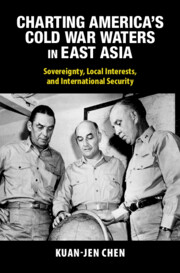 Charting America's Cold War Waters in East Asia
Charting America's Cold War Waters in East Asia Published online by Cambridge University Press: 23 May 2024
This chapter argues that US maritime policy was not limited to the construction of geostrategic space but also extended to the international political arena. The author analyses how the United Nations Conferences on the International Law of the Sea in 1958 and 1960, intended for legal discussion, became embroiled in the rivalry between the United States and the Soviet Union. The chapter explores how the United States sought a legal basis for its maritime dominance at these conferences and how its hub-and-spoke allies in East Asia responded to these efforts. Despite the support of its allies, the United States faced challenges in obtaining their backing in confronting Soviet challenges to the international law of the seas, due to issues of local sovereignty and interest. The author also examines the reasons behind Washington’s decision to change its stance on the breadth of territorial waters and how its East Asian allies responded to this shift. Overall, the chapter provides insight into the complex dynamics of US maritime policy in East Asia and its impact on international relations.
To save this book to your Kindle, first ensure [email protected] is added to your Approved Personal Document E-mail List under your Personal Document Settings on the Manage Your Content and Devices page of your Amazon account. Then enter the ‘name’ part of your Kindle email address below. Find out more about saving to your Kindle.
Note you can select to save to either the @free.kindle.com or @kindle.com variations. ‘@free.kindle.com’ emails are free but can only be saved to your device when it is connected to wi-fi. ‘@kindle.com’ emails can be delivered even when you are not connected to wi-fi, but note that service fees apply.
Find out more about the Kindle Personal Document Service.
To save content items to your account, please confirm that you agree to abide by our usage policies. If this is the first time you use this feature, you will be asked to authorise Cambridge Core to connect with your account. Find out more about saving content to Dropbox.
To save content items to your account, please confirm that you agree to abide by our usage policies. If this is the first time you use this feature, you will be asked to authorise Cambridge Core to connect with your account. Find out more about saving content to Google Drive.